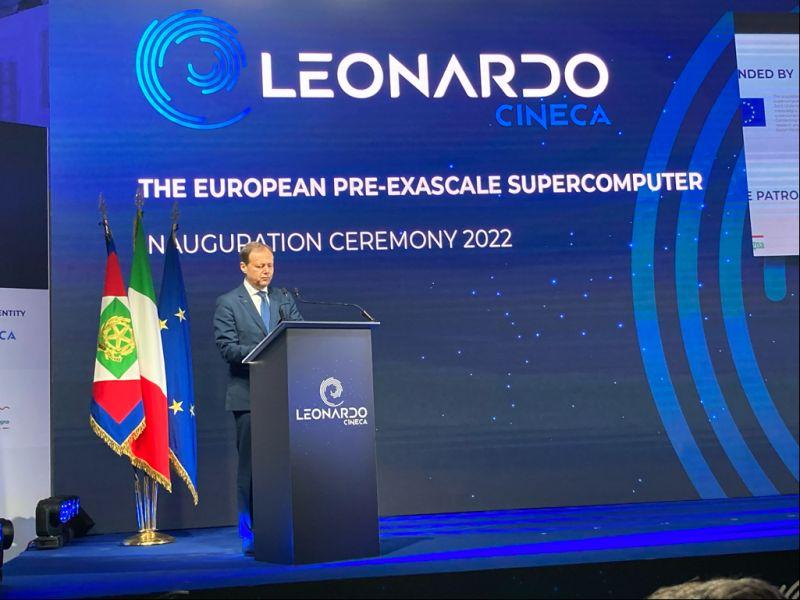LEONARDO, the newest EuroHPC pre-exascale supercomputer ranked fourth fastest in the world, was inaugurated in the Bologna Technopole in Italy by the European High-Performance Computing Joint Undertaking (EuroHPC JU) and CINECA. EuroHPC JU is a shared intensive project aiming to build exascale supercomputers with the ultimate goal to strengthen the European presence in high-performance computing worldwide.
During the inauguration ceremony, in presence of Italian president Mattarella, the second data center in Tecnopolo was also opened. 80% of the Italian and 20% of the European computing power is now concentrated in Bologna.
The festive event in presence of Italian President Mattarella, the Cardinal, high dignitaries of the region and Mr. Roberto Viola, Director General of DG CNECT, European Commission, is yet another culminating point of a voyage that started in 2018 with the launch of EuroHPC. Europe has impressively taken significant steps toward the implementation of a unified High-Performance Computing (HPC) infrastructure. The event marks the establishment of the first petascale-class supercomputer, which will provide European countries with the opportunity to unlock the benefits of HPC technologies. The launch will enable advanced computing capabilities, necessary for the development of advanced research and development capabilities in the region. This event marks a milestone in Europe’s journey towards a unified and advanced HPC infrastructure, and will undoubtedly serve as an example of successful cross-border collaboration.

There is talk of an investment of more than 120 million euros, half of which will come from the European Commission fund and the rest from other organizations involved in the project: Italy, Austria, Greece, Hungary, Slovakia and Slovenia. The project plans in particular to be able to develop its power and its capacities in the years to come, in particular in connection with quantum computing.
LEONARDO’s system is based on the architecture conceived and developed by Atos’ BullSequana XH2000 solution, which is appropriate for high-intensity computing tasks such as data processing, High-Performance Data Analytics (HPDA) and machine learning. It will become the second most powerful computer in Europe (after its Finnish HPC system sibling “LUMI”), and the world’s fourth most powerful computer. Atos now has 43 supercomputers in the TOP500, with two new systems joining the list, including Leonardo and Petrobras’ Pégaso system.
It has a total of 3,500 Xeon processors, 14,000 NVIDIA A100 GPUs, includes 4,992 Intel Ice Lake calculation nodes, 100 Po of storage, for an overall power of 249 PFLOPS in the long term, and 175 PFLOPS for the moment.
It is intended for use in research projects, scientific and academic purposes, and industrial applications, it will be also used for a variety of the most demanding applications including cancer research, materials science, biomedicine, climate change, engineering, modeling of the human brain, and AI development.
However, the European Commission’s project does not end there: further installations, such as the Deucalion in Portugal and the MareNostrum5 in Spain, are planned around Europe. Not to mention the establishment of six additional sites for the hosting of quantum computers that will be integrated with current supercomputers.

Interesting facts about LEONARDO Supercomputer:
- Fully developed and assembled in the European Union, Leonardo will have a computing power of nearly 250 petaflops (250 “million billion” calculations per second).
- It is currently the fourth most powerful supercomputer in the world (and climbing).
- LEONARDO is particularly suited for compute-intensive tasks, such as high-performance data processing and MachineLearning
- LEONARDO + LUMI + MARENOSTRUM will form the most powerful HPC infrastructure on Earth
- LEONARDO also contributes to the EUGreenDeal goals as it focuses on environmental sustainability and is equipped with tools enabling a dynamical adjustment of power consumption, thus granting a smart and optimal balance between energy saving and performance. Moreover, it uses water cooling for increased energy efficiency.
- Next to LEONARDO, there will be soon one of six Quantum computers in Europe (source)
How does Leonardo compare with the fastest machines?
The current performance of the Leonardo computer is 174 PFLOPS (174 million billion calculations per second), representing a significant amount of computing power. While this figure is impressive, it falls short of the five fastest computers in the world.
The Frontier supercomputer located in the United States has a performance of 1,102 PFLOPS, while the Fugaku supercomputer in Japan has a performance of 442 PFLOPS. Third place is currently held by the LUMI supercomputer in Europe at 350 PFLOPS.
Top 5 supercomputers in the world :
1. Frontier – US – 1,102 PFLOPS
2. Fugaku supercomputer – Japan – 442 PFLOPS
3. LUMI – Finland – 309 PFLOPS
4. Leonardo – Italy – 174 PFLOPS
5. Summit – US – 148 PFLOPS
It is interesting to note that the top 5 fastest computers in the world all come from countries other than China, with the fastest computer ranked 7th at 93 PFLOPS. This shows that while China is a leader in technological advancement, it has yet to catch up with the rest of the world in terms of the speed and power of its computers.
The TOP500 project has been tracking the world’s most powerful supercomputers since 1993, and Europe’s performance in this ranking has been remarkable. Thanks to Lumi No3 and Leonardo No4, Europe now has two machines at the Top4 of the TOP500 project, the first time since its launch.
Furthermore, the number of European supercomputers ranked in the Top500 has grown from 97 to 138 since the inception of EuroHPC Joint Undertaking in September 2018, indicating a substantial increase in Europe’s computing power.
This is an important achievement and a testament to the commitment of European governments and businesses to investing in technology. Going forward, it is likely that the number of European supercomputers in the Top500 will continue to grow, pushing the boundaries of what is possible.
The inaugural event of Leonardo Cineca can be watched here:



